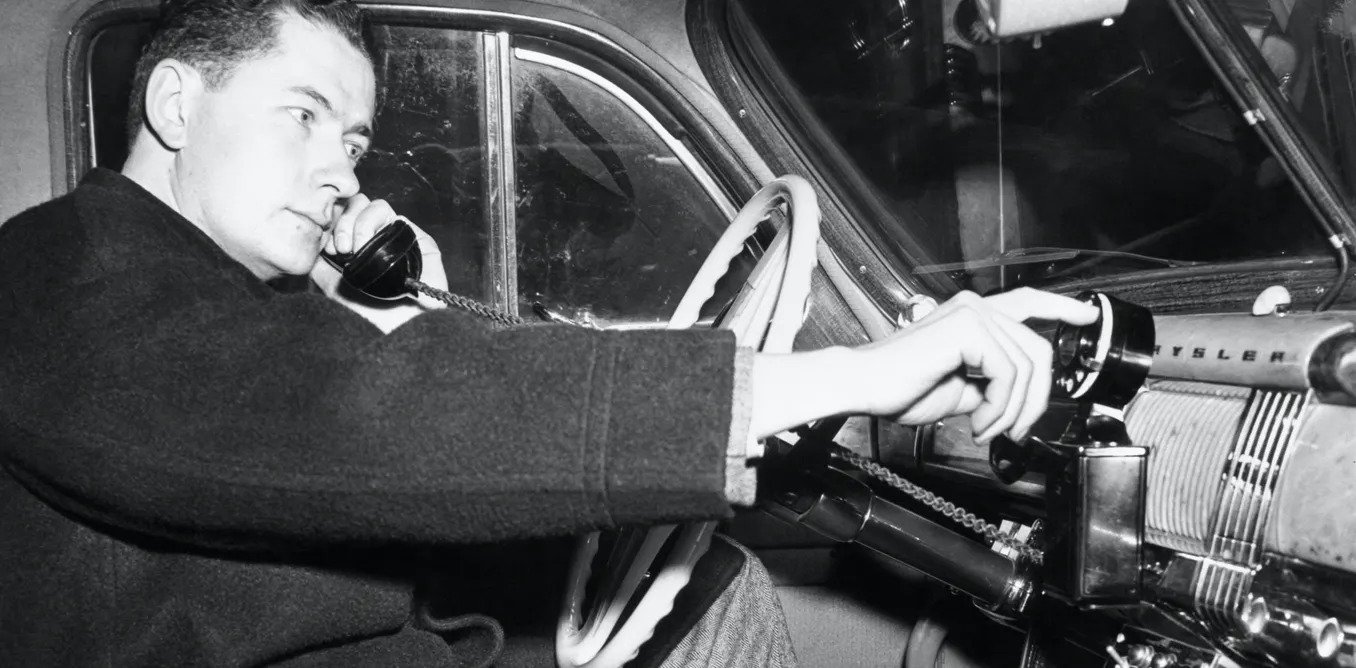 An engineer demonstrates a car phone five months before the historic first call on a competing company’s commercial mobile telephone service in 1946. Bettmann via Getty Images
An engineer demonstrates a car phone five months before the historic first call on a competing company’s commercial mobile telephone service in 1946. Bettmann via Getty Images
2021 Jun 16
–
I have a cellphone built into my watch. People now take this type of technology for granted, but not so long ago it was firmly in the realm of science fiction. The transition from fantasy to reality was far from the flip of a switch. The amount of time, money, talent and effort required to put a telephone on my wrist spanned far beyond any one product development cycle.
The people who crossed a wristwatch with a cellphone worked hard for several years to make it happen, but technology development really occurs on a timescale of decades. While the last steps of technological development capture headlines, it takes thousands of scientists and engineers working for decades on myriad technologies to get to the point where blockbuster products begin to capture the public’s imagination.
The first mobile phone service, for 80-pound telephones installed in cars, was demonstrated on June 17, 1946, 75 years ago. The service was only available in major cities and highway corridors and was aimed at companies rather than individuals. The equipment filled much of a car’s trunk, and subscribers made calls by picking up the handset and speaking to a switchboard operator. By 1948, the service had 5,000 customers.
–
The first handheld mobile phone was demonstrated in 1973, nearly three decades after the introduction of the first mobile phone service. It was nearly three decades after that before half the U.S. population had a mobile phone.
Big history in small packages
As an electrical engineer, I know that today’s mobile phone technology has a remarkable number of components, each with a long development path. The phone has antennas and electronics that allow signals to be transmitted and received. It has a specialized computer processor that uses advanced algorithms to convert information to signals that can be transmitted over the air. These algorithms have hundreds of component algorithms. Each of these pieces of technology and many more have development histories that span decades.
A common thread running through the evolution of virtually all electronic technologies is miniaturization. The radio transmitters, computer processors and batteries at the heart of your cellphone are the descendants of generations of these technologies that grew successively smaller and lighter.
The phone itself would not be of much use without cellular base stations and all the network infrastructure that is behind them. The first mobile phone services used small numbers of large radio towers, which meant that all the subscribers in a big city shared one central base station. This was not a recipe for universal mobile phone service.
Engineers began working on a concept to overcome this problem at about the time the first mobile phone services went live, and it took nearly four decades to roll out the first cellular phone service in 1983. Cellular service involves interconnected networks of smaller radio transceivers that hand off moving callers from one transceiver to another.
Military necessity
Your cellphone is a result of over a hundred years of commercial and government investment in research and development in all of its components and related technologies. A significant portion of the cutting-edge development has been funded by the military.
A major impetus for developing mobile wireless technologies was the need during World War II for troops to communicate on the move in the field. The SRC-536 Handie-Talkie was developed by the predecessor to Motorola Corporation and used by the U.S. Army in the war. The Handie-Talkie was a two-way radio that was small enough to be held in one hand and resembled a telephone. Motorola went on to become one of the major manufacturers of cellphones.
The story of military investment in technology becoming game-changing commercial products and services has been repeated again and again. Famously, the Defense Advanced Research Projects Agency developed the technologies behind the internet and speech recognition. But DARPA also made enabling investments in advanced communications algorithms, processor technology, electronics miniaturization and many other aspects of your phone.
https://youtu.be/fnKlVtTjBaw
Looking forward
By realizing that it takes many decades of research and investment to develop each generation of technology, it’s possible to get a sense of what might be coming. Today’s communications technologies – 5G, WiFi, Bluetooth, and so on – are fixed standards, meaning they are each designed for a single purpose. But over the last 30 years, the Department of Defense and corporations have been investing in technologies that are more capable and flexible.
Your phone of the near future might not only fluidly signal in ways that are more efficient, enable longer ranges or higher data rates, or last significantly longer on a charge, it might also use that radiofrequency energy to perform other functions. For example, your communications signal could also be used as a radar signal to track your hand gestures to control your phone, measure the size of a room, or even monitor your heart rate to predict cardiac distress.
It is always difficult to predict where technology will go, but I can guarantee that future technology will build on decades upon decades of research and development.
[Get the best of The Conversation, every weekend. Sign up for our weekly newsletter.]
–
Want to write?
Write an article and join a growing community of more than 128,700 academics and researchers from 4,063 institutions.








